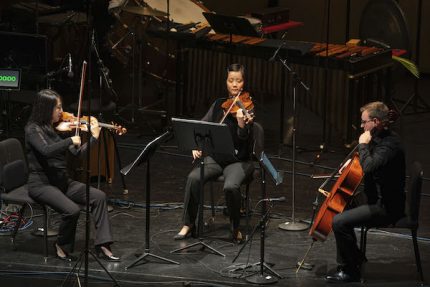From code to stones, MusicNOW offers an eclectic mix

MusicNOW opened its season Monday night at the Harris Theater with a typically eclectic mix titled “Community Acoustics.” Missy Mazzoli, starting her second and final year as Chicago Symphony Orchestra composer in residence, once again proved an admirable and unflappable host—moving the proceedings along efficiently and conducting brief but insightful pre-interviews with the four composers who were in attendance to introduce their works.
If the results were typically mixed as new-music programs tend to be, the performers provided consistently strong advocacy and the evening brought two premieres and some welcome new composers to the local scene.
The evening led off with the world premiere of Code Switch by Wang Lu. The composer stated that the work—scored for brass quartet and percussion—was inspired by sharply contrasted elements: traditional brass fanfares, Asian folk music improvisations and Chinese “socialist military marches.”
That when-worlds-collide gumbo was clearly manifest. A long, ominous bass drum roll ushers in menacing, angular brass fragments, quasi-fanfares, jazzy muted trumpet riffs, and swoony trombone glissandos. Wang’s piece makes bracing impact with emphatic punch, yet the anarchic interplay begins to feel a bit directionless before reaching its abrupt coda. That was through no fault of the excellent players—trumpeters David Inmon and Matthew Baker, hornist David Griffin, trombonist Charles Vernon and percussionist Ian Ding—all of whom provided gleaming and pinpoint advocacy.
By far the most successful work of the evening was Figure to Ground by Eliza Brown. Inspired by Susan Stewart’s “Poem from Hölderlin” this string trio reflects Stewart’s zoom-lens approach to cyclical patterns, of leaves and various natural phenomena, extending to seasons and generations.
If the poem’s inspiration is not always evident, Brown’s score proved hugely compelling. The tempo is slow and dynamics rarely rise above a whisper. Yet in its buzzy tremolos, high fragments, and wispy violin tendrils, the music conveys an atom-blasted sonic landscape with music of extraordinary power and hushed intensity. The tempo accelerates in the middle section for a folk-like melody, before an elegiac theme for viola returns the work to the spare, unsettled atmosphere of the opening.
Violinist Yuan-Qing Yu, violist Weijing Wang and cellist Calum Cook explored a remarkable array of rarefied pianissimos in this performance, playing with taut, laser-like concentration.
Also heard Monday was Francesca Verunelli’s Magic Mauve and Finola Merivale’s The Language of Mountains is Rain.
Scored for percussion and acoustics, Magic Mauve’s harmonic material is derived, says Verunelli, from the detuning of a 17-key celesta. The abstract goal of the work is to stretch the limits of its content via temperament, harmony and line.
Verunelli conjures up a kaleidoscopic array of arresting high timbres, often using offbeat methods, including bowing the instruments for a haunting, theremin-like sonority. Still, I’m not sure Magic Mauve avoids the pitfall of many solo percussion works, failing to establish a larger or deeper context beyond its shimmering surface colors and unorthodox methodology.
Here too, the score was lacking nothing in advocacy from soloist Cynthia Yeh who brought nuanced and athletic virtuosity to all its dizzying demands. As Mazzoli noted, Yeh had to prepare and rehearse Verunelli’s work simultaneously while doing the same for Avner Dorman’s concerto Eternal Rhythm, which the CSO’s principal percussionist performed for three nights running last week. “I’m buying the drinks the rest of the season!” said Mazzoli.
Like the Brown work, Merivale’s The Language of Mountains is Rain also has a literary source, in this case a chapter title from David Mitchell’s novel number9dream. Cast in three short movements, the string quartet is an attempt to “explore the idea of rain,” said the Irish composer.
The work mixes grinding Bartokian dissonance and pizzicatos with fleeting lyrical lines, and high, hushed shards of violin tone. If ultimately adding up to less than the sum of its parts, violinists Yu and Simon Michal, violist Wang and cellist Cook provided a finely focused rendering.
The interval-less evening closed with LJ White’s Community Acoustics, which gave the program its title. Originally written for orchestra, the work was heard in the premiere of a new arrangement for 13 players, commissioned by MusicNOW.
As White explained, the title is an ecosystem term for how organisms naturally organize themselves into distinct spaces in relation to a larger community. Inspired by nature field recordings, the musical material reflects the composer’s intent of creating a sonic musical ecosystem from divergent elements. White added that he hoped the same for the larger universe of distinct human communities living in harmony with each other—something all can agree on in these socially and politically polarized times.
A large chamber orchestra on stage at MusicNOW usually means a closing work that is fast, loud and brilliant. Community Acoustics goes in the opposite direction however—feeling more like a relaxed and soothing walk through a kind of musical terrarium. Distinct instrumental lines, timbres and fragments appear and recede without disturbing the overall organic flow and natural order, the myriad lines of the ensemble meticulously balanced and directed by conductor Michael Lewanski.
White’s audience participation element of having Harris patrons play two stones may have reflected the communal ideal in the abstract but it predictably produced an unvaried din initially. Fortunately, the sound soon lessened to something like the intended nature effect; Lewanski’s graceful sweeping gesture gradually quelled the audience contribution to silence and was deftly timed to coincide with the musicians coming to the double bar onstage.
MusicNOW continues with “Obscure Clues and Shiny Objects” 7 p.m. December 2 at the Harris Theater. cso.org
Posted in Performances


